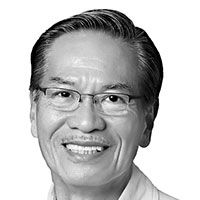Free haircuts and such: ‘Peace and development’?

What’s the Duterte government’s plan, midway in its six-year term, for attaining that elusive goal of peace and development?
In mid-January, the Presidential Communications Operations Office came out with glowing statistics and data on over 15 supposed achievements that it dubbed as “Duterte’s legacy.”
At once, critics drubbed the presentation, with a respected data cruncher (IBON Foundation) calling it “a really crude propaganda tactic: repeating a lie often enough for people to believe it.” And worse, NEDA chief Ernesto Pernia distanced himself from the Malacañang functionaries, grunting that the “legacy” numbers were “not shown to me for comments.” Furthermore, he pointed out that some data weren’t presented properly and needed clarifications. In effect, the PCOO served a flatulence-inducing smorgasbord menu.
On Feb. 1, it was the turn of the Office of the Presidential Adviser on the Peace Process to drumbeat the government’s “successes” in its “current inclusive peace and development efforts.” OPAPP head Carlito Galvez Jr. claimed that “the armed struggle has no legitimacy” and the CPP-NPA “is fast losing its clout and relevance… and should be disbanded.”
Galvez, a former AFP chief, was roundly rebuked by the National Democratic Front of the Philipppines negotiating panel in The Netherlands. Last December, the NDFP panel had had productive informal discussions with Labor Secretary Silvestre Bello III – sent there by Duterte – regarding a return to the negotiating table after the latter’s abrupt termination of the GRP-NDFP peace talks” in November 2017. Responding to Galvez’s assertion, the panel, headed by Fidel V. Agcaoili, said:
“Just as the call for the resumption of peace negotiations is gathering strength and the Duterte regime appears prodded back to the negotiating table, OPAPP seems hell bent on derailing every effort to resume the peace talks.”
“OPAPP has long lost all credibility, and has become irrelevant,” the panel countered, pointing out that by opposing the resumption of peace negotiations it’s “thereby negating the very title of its office – becoming the office against the peace process.”
Under Galvez, the panel said, the OPAPP has become “part of the military psywar machinery in attempting to deny the existence of the armed conflict between the forces represented by the GRP and the NDFP. It thus sabotages the process of resolving it through peace negotiations between the two parties with the forging of agreements on basic social, economic, and political reforms to pave the way for a just and lasting peace.”
As for the “successes” of Executive Order No. 70 and its National Task Force-ELCAC (Ending the Local Communist Armed Conflict) that Galvez claimed to have attained, the NDFP panel called EO 70 “a fascist decree” that “put under military supervision the entire civilian bureaucracy, including its resources, in the vain attempt to defeat the revolutionary forces.” EO 70, it added, is an integral part of Oplan Kapayapaan, the Duterte government’s revised counterinsurgency program.
EO 70’s ultimate objectives, according to Galvez, are “social justice and equitable service to humanity” through the NTF-ELCAC’s “localized peace engagement (LPE).” The LPE, he said, aims to “empower people, make communities conflict-resilient, and provide a safe and direct line of communication between the government, the people, and rebels who want to give up armed struggle.”
How? “We are already doing it right now, through a more comprehensive, efficient and timely delivery of basic services and livelihood assistance programs for the former members of the (NPA) and the affected communities [emphasis mine].”
An example of this, from Mindanao, was the recent launching of “Serbisyo Caravan,” in a sitio of Barangay Mat-i, Surigao City.
As reported by the PCOO’s Philippine Information Agency, the activity was presided over by Mayor Ernesto Matugas Jr. It began with the ceremonial turnover of livelihood assistance (cattle dispersal) to five households, distribution of hygiene kits – soap and toothpaste, presumably – to 120 households, followed by the provision of “basic services” to the residents; these meant “dental-medical services, free haircut, supplemental feeding, distribution of slippers and “lice alis” packs to pupils of an elementary school, vaccination and deworming. The residents were also given pieces of paper telling them how and when to apply for an NBI clearance, and for help from government lawyers.
There was no mention of assuring the people of better jobs and income opportunities, much less security of land tenure.
Instead, Galvez talked about a P21-billion proposed budget for this program, which national security adviser Hermogenes Esperon Jr. (NTF-ELCAC vice chair) explained will be split up this way: P16.840 billion for 842 “insurgency-cleared” barangays across the country and P4.189 billion for 2,793 “insurgency-threatened” barangays.
Esperon explained that P20 million would be allotted to each of the 842 “cleared” barangays for farm-to-market roads, school buildings, water and sanitation systems, national greening program (reforestation), health stations, electrification, agricultural projects, TESDA training, and DICT connectivity projects. For the “threatened” barangays, the projects would be water systems, barangay centers, schoolhouse repairs, support for household projects, housing projects, road opening, and agricultural support. He didn’t say how the P4.189 billion would be allocated to 2,793 barangays.
He said President Duterte had approved the budget “in principle,” meaning it couldn’t be immediately allotted yet. Also, it’s not clear if the funding would be for fiscal year 2020 only.
Note that the proposed budget is only applicable to “conflict-affected” barangays -- spread out in 76 of 81 provinces in the country – per a 2018 AFP report, cited by an Ateneo de Manila University professor. (I referred to that report in this column on August 3, 2019.) That AFP report did not mention the number of barangays affected by the more than 50-year armed conflict.
Likewise, note that the 3,635 barangays targeted for funding by the NTF-ELCAC constitute a very tiny portion of the 42,045 barangays in the country as of May 2019. Most probably a big percentage of these barangays have the same needs as the “conflict-affected” ones. What does the Duterte government plan for their “development” to attain what the OPAPP calls “social justice and equitable service to humanity”? Also, the 842 “cleared” barangays are only a third of the 2,793 uncleared ones. With the grossly disproportionate fund allocation, how and when could each of the latter get to be “cleared” as to deserve the P20-million allotment?
A lot more questions can be raised over the EO 70/NTF-ELCAC objectives and methods. Recently, the PIA reported about kindergarten and day-care center pupils being brought to Philippine Army camps in Agusan del Sur and Bislig City, along with their parents and teachers, to tour the facilities, listen to a soldier’s lecture, and watch the disassembling and reassembling of high-powered firearms.
Ditto, there are more questions on “localized peace engagement” as a substitute for pursuing the GRP-NDFP peace negotiations on social, economic, and political reforms, which the two panels both affirm as having attained “unprecedented” advances in the early part of Duterte’s watch.
* * *
Email: [email protected]
- Latest
- Trending




























